ARCHITECTURAL PROJECTS
RESIDENTIAL
04 October, 2010
VI: Unrecycling Cyclades. Part 1
The residential prototype confronts, challenges and contrasts the ultimate stereotype of vacation home design in Hellenic seafront locations.
Text by Aristotelis Dimitrakopoulos, 2007.
Credits:
Designer: Aristotelis Dimitrakopoulos
Structural Consulting: Nikos Baramboutis
Drafting: Vasiliki Gkioka
Architheke VI is residential project designed by Dimitrakopoulos, currently in preliminary schematic design. The project sets a prototype for architectural interventions in challenging sites where building code is geared towards promoting and replicating traditional forms. The building code is composed with good intentions, arriving though in many cases to an imitation of tradition that is fully dismissed by the Aristotheke Design Agenda. The quest towards a formal language and a programmatic agenda that bridges the contemporary with the contextual is investigated through a series of projects [Architheke VI - X]. Architheke VI is the first and most developed among those. Note: the current design for the swimming pool is shown only in the specific perspective collage [see photo] that focuses on the infinity edges and the horizon views, while the linear perspectives and the text refer more to a previous version of the swimming pool.
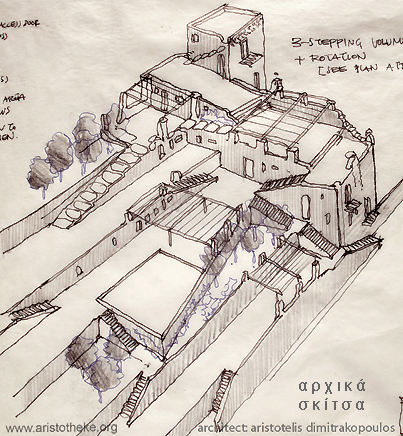
Against Conventions: The Architheke VI prototype confronts, challenges and contrasts the ultimate stereotype of vacation home design in Hellenic seafront locations, namely the 'wide box' set parallel to the topographic lines with the larger dimension facing the view and a swimming pool platform upfront extending towards the horizon views. Negating this ultimate conventional given was a central intention of the project. The wide box stereotype entails a number of strategic flaws: prescribes the emergence of a front and a backyard and the erasure of the natural contours.
The wide box resists, cancels and reverses the topography to create horizontality where it never existed. This translates into tremendous and costly landfill to flatten out the hill for the creation of the front platform. Secondary result of the cliché "wide box" scheme set on a steep sloping landscape is the problematic, second-rate space generated behind the house, a dead-end squeezed between excavation earthworks and the prism. Regarding the frontal elevation, the effect is a disturbing view of tall disproportionate retaining walls holding the landfill. For the particular site at Fero Chorio in Tinos, a gravel roadway -lining the lower boundary line of the lot- is actually the sole access route and the main public exposure of the house making even more significant the frontal view from the lower contours.
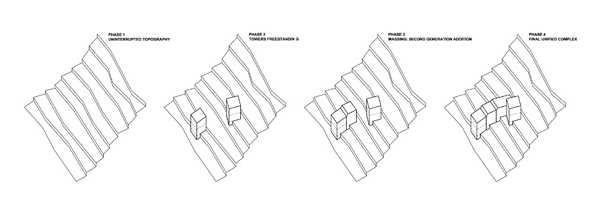
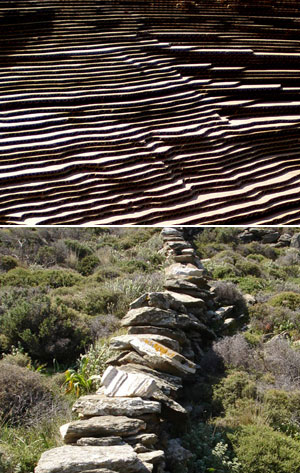
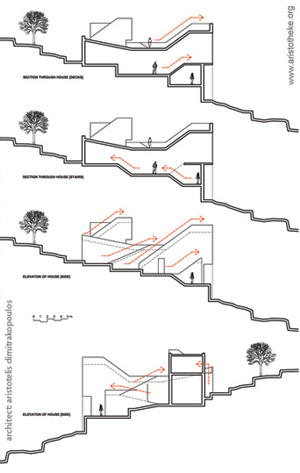
Anti-Stereotype: Architheke VI eliminates these issues suggesting a new tectonic and programmatic prototype. The main volumetric entity intersects the contour lines, rises and thrusts into the horizon opening the long sides towards the topography, integrating the immediate natural terrain and optimizing the use of the full property width. By energizing the spaces adjacent to the oblong volume the proposal extends and multiplies the living spaces, enabling numerous possibilities for habitation patterns. The movement trajectories engage the sideward openness and reveal staged diagonal perspectives, multiplying the opportunities to relate to the dramatic vistas. The theatrical organization of movement, of strategic scenes integrating the natural setting into all activities, permits a deeper association with the Aegean.
Rural Turrette: Non-urban habitation was traditionally rare in the Cyclades. The constant concern and risk of exposure to intruders and pirates directed the emergence of dense and tight urban enclaves with austerely defined perimeter, wedged on extreme topographic settings. Remote and isolated tectonic complexes were typically of fortress-like nature, offering defense mechanisms and emergency patterns in the scenario of sudden intrusion. Strategic siting permitted optimum visual control of the topographic terrain. Compressed building footprints and vertical tectonic elements [towers created under the obvious limitations posed by the rough stone masonry construction techniques available] were the ultimate expressions of the defensive nature [observed in various Hellenic coastal regions, in the islands as much as in mainland, such as the Peninsula of Mani].
Coastal Chateau: Architheke VI recognizes this idiom and prioritizes the integration of contemporary programmatic agendas in the physical and tectonic context, expanding on established patterns of habitation. This intention in no case translates into replicas of historic traces or to their mummification for temporal entertainment purposes. On the contrary, it constitutes a sincere and direct commitment to the experiential attributes of this rough locale, to sensing the formal syntax of the region.
Re-thinking Villa: Through design research, the project undertakes a full initiative for the definition of an architectural language that re-thinks the "vacation home" typology, embedding the everyday living patterns into the topographic milieu. The conscious exposure to Mediterranean "life politics" is an ultimate priority. Architheke VI sits in total contrast to "no-purpose" sunbathing yards and Disney-like resorts that replicate a supposedly "authentic" local character. This directive responds to the conceptual quest: a philosophy of habitation and architecture defining contemporary agendas in the rural Cycladic realm.
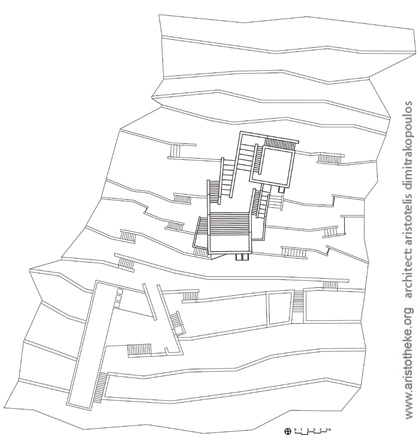
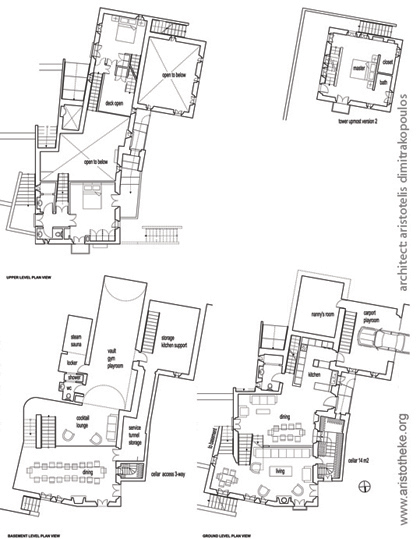
Toposcape: The project recognizes the primary feature of the Cycladic landscape, the "constructed" topography; a man-made stepping slope organized by a primordial retaining wall system of rough stone masonry. This fabric directed the staggered sectional scheme for the living spaces and the roofscape.
Plasticity + Sculpting: Vernacular architecture in the Cyclades establishes a formal language emphasizing the subtle manipulation of solid mass through restrained operational moves. The local materials and the visceral building techniques available implied a tectonic syntax of interconnected solid masses merging into flowing compositional complexes, accentuated by the unifying layers of white stucco.
Aristotheke VI extends this visual and tectonic syntax serving contemporary programmatic agendas through current building techniques and materials, demonstrating that the wide spectrum of services included in a private residence does not necessitate a morphological schism from the vernacular.
Movement Schematized: Circulation trajectories carve into the tectonic forms generating a composition demonstrating increased responsiveness to the variable moods of the dweller. Experiencing the house evolves into a process of discovering habitation patterns implied by the tectonic ensemble. Common cause of failure to contextualize with a physical terrain is the poor integration of built volumes into the landscape. Focusing on this directive and optimizing the relation to a natural setting of straightforward, raw beauty, the house becomes an extension of the stepping topography, continuing this dialogue of connectivity between staged decks and platforms. The movement scheme is evident even in the early concept sketches.
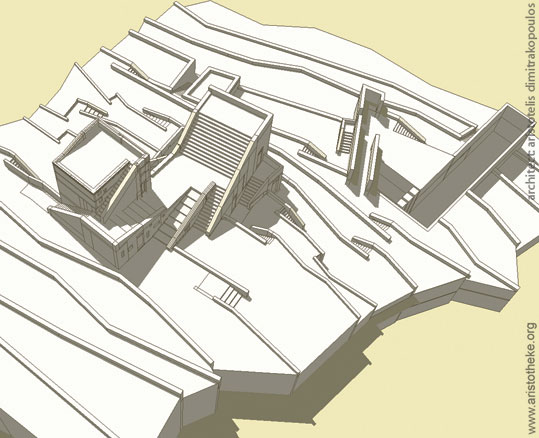
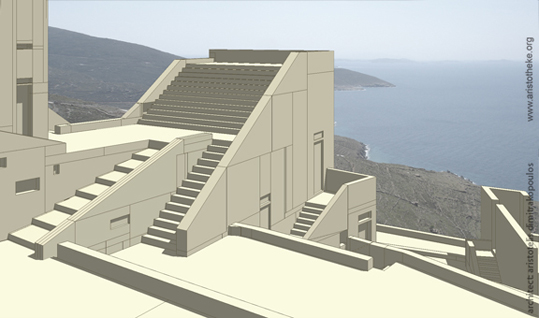
Experiential Attributes: The interior space is envisioned as enveloping a linear movement scheme that operates in section, stepping downwards along with the topography, then branching upwards into a mezzanine. The accessible terracing roofscape expands on this concept. Multiple access points to the roof predicate the house not an object place on the hill, but as integral to the hill. The stepping terraces are a reversal of the natural pattern of movement [upward rather than downward], suggesting a series of ascending paths that establish a flowing habitable terrain. Increased attention is given to outdoor elements of sectional circulation: stairs and ramps are embedded into the main volumetric mass, as carved into the solid; as elaborations of the natural landscape, renouncing the modern expression of the stair as a prosthetic element. In other words, stairs and ramps are not articulated as add-on elements that protrude or cantilever resisting gravity.
Helix Volumetrics: Multiple layers of volumetric analysis operate simultaneously. Considering the interior spaces, the synthesis consists of an oblong volume protruding with its long dimension set perpendicularly to the topographic lines, and an adjoining tower higher up, set almost at a corner, partially superimposed over the main cuboid. In a more detailed examination, a series of smaller volumetric elements organizes the composition: the main elongated prismatic form can be further analyzed into three almost rectangular forms stepping down the topographic terrain, each slightly rotated in relation to the previous. The sectional descent becomes more dramatic in the interior section and is moderately evident in the terracing roof plan. Each of these cuboids becomes wider than the previous. Outdoor stairs are carved out of the solid mass at these intersections. The enclosed volume added to each consecutive volume becomes a service zone [hygiene spaces]. This staggered scheme is evident in the differentiation of the roof-slab section but mostly in the subtle break-and-twist of the volumes in plan revealing progressively traces of a helicoid organization.
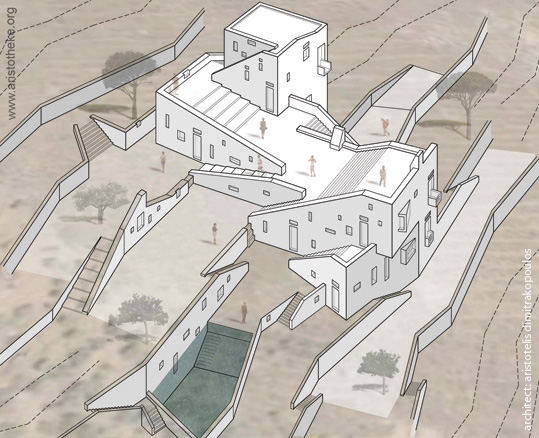
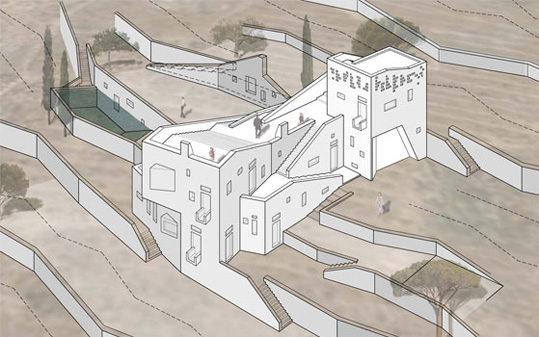
Simulated Evolution: Historic structures in the region are products of gradual and phased interventions that transform, expand and rework pre-existing edifices. Architheke VI can be analyzed into simulated growth phases that further articulate the inscribed contextual nature. The front segment of the main oblong prism [housing the bedroom suite, the living room and potentially a below-grade cellar] can be examined as a tower form. With clear outlines and soaring height, this tower is eventually built-in, becoming part of a larger mass through the cubical single-story volume addition of the entry lobby/dining area. A third-phase programmatic extension brings into one composition the two initially freestanding towers, as a third prism containing the upper bedroom flanks the master suite tower. The simulated growth phases are displayed clearly in the "exploded" volumetric diagrams: A. initially a set of monastic towers exists in the Cycladic mountainside. B. the two-partite composition becomes densified through the addition of a central mass adjoining the lower tower. C. a third cuboid completes the synthesis filling the void between the former volumes.
Flowing Programmatics: The oblong main volume positioned perpendicularly to the contour lines allows a number of intermediate decks to develop, enabling long views throughout the interior space and panoramic glimpses of the Aegean. The main space of the house is contained within this single, unified prismatic volume, allowing decks of varied use to "terrace" and look into the central area. The split-level organization of the basic volume maintains a sense of unity and amplifies an illusion of size in the interior spaces. The central volume of the entry lobby/eating area becomes a hub, a distribution node and reference point of everyday life, the strategic cross-sectional quasi-servant room. A workspace, a semi-separated guest room, two bedrooms, the food preparation zone and a living area are distributed in adjacency to this main distribution hub.
Related articles:
- HORROR VACUI: JOSTLE, HUDDLE AND HELLENIC MODERNITY ( 21 June, 2005 )
- ATTIC ECTOPIA ( 16 November, 2012 )
- FRONTAGE SHOWCASES AND THE POST-URBAN UNCANNY-A RECTROACTIVE MANIFESTO FOR HELLENIC PROFESSIONAL SPACES ( 01 January, 2010 )
- Gwangju Asian Cultural Center, Korea – International Competition Entry, October ( 7 December, 2007 )
- De-institutionalizing Education: Notes on Academic Initiatives(i) ( 7 July, 2007 )
- HARBORING CAR-BAN-ITIES [Port Nord Organizational Protocols] ( 8 October, 2007 )
- Stratifying Axialities> Celadina ReCelled (PART A) ( 14 March, 2008 )
- Stratifying Axialities> Celadina ReCelled (PART B) ( 11 April, 2008 )
- FRAGMENTARY IMPUNITIES > VALLADOLID TRAJECTORIES (PART A') ( 5 September, 2008 )
- FRAGMENTARY IMPUNITIES > VALLADOLID TRAJECTORIES (PART B') ( 5 November, 2008 )
- SUBTERRA * SUPRATERRA ( 22 May, 2009 )
- VI: Unrecycling Cyclades. Part 2 ( 14 October, 2010 )
- Translocality as a Post-Native Narrative ( 16 February, 2011 )
- Metaxekisis : Re-Thinking the Athenian Court ( 08 December, 2010 )
- L-I*-THEKE ( 02 April, 2013 )
- House - glyptotheque - gallery - workshop ( 19 July, 2013 )
- Piloting Pilotis ( 31 December, 2013 )
- Escalteca of the Choetheque Series ( 01 April, 2014 )
- Schottheke of the Choetheque Series ( 01 June, 2014 )
- Floatheca Rh of the Choetheque Series ( 01 August, 2014 )
- Floatheca Sp of the Choetheque Series ( 26 September, 2014 )
- O-theke of the Choetheque Series ( 11 March, 2015 )
- Floatheca Cy of the Choetheque Series ( 03 January, 2015 )
- Ophthalteca ( 24 June, 2015 )
- Y-theca of the Choetheque Series ( 08 October, 2015 )










